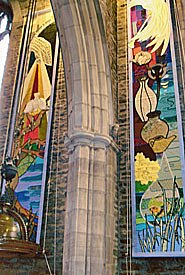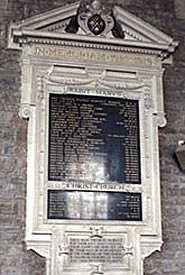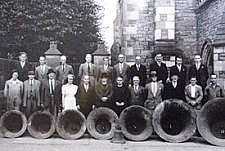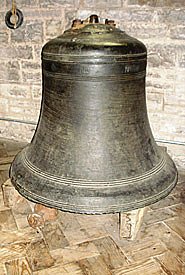THE HISTORY of St Mary's Parish Church, St Mary's Priory, Abergavenny
‘This is the Westminster Abbey of South Wales, for the great ones of all the ages lie here – Norman, Plantagenet, Tudor and Stuart – with carved wood or marble or freestone above them.’
St Mary’s Priory, Abergavenny, is no ordinary Church; it was founded in 1087 as a Benedictine Priory alongside the frontier castle in the reign of William 2nd, by Hamelin de Ballon, the first Norman Lord of Abergavenny, and was intimately connected with the Lordship thereafter. Both the Priory and the Castle were focal points in the turbulent times of the Welsh Wars which followed the Norman incursion into Wales, particularly into the areas known as the ‘Welsh March’, close to the old borders with England.
As well as housing an outstanding collection of beautiful tombs and monuments, which have been restored, there are many, many artefacts and much information about people and incidents which paint a fascinating picture of life and times in the mediaeval period, not just locally but having impact throughout the Country. The Plantagenets and their cohorts, the rise of the Tudors and their impact on saving the Priory contents from harm at the Dissolution and the later movements of Charles 1st are all witnessed.
The Priory has alongside it the beautifully restored Tithe Barn, which provides a vivid interpretation of the history of the Priory and Abergavenny and houses the extraordinary Abergavenny Tapestry, some 24’x 6’ which also helps the understanding of the last 1000 years. Group or individual tours of the Priory and Exhibition can be easily arranged through the Tithe Barn Reception and tailor made to match the level of interest of the participants.
Wall Hangings
 |
The two exquisite wall hangings which grace the Baptistry of St Mary’s Priory were designed and made by Elizabeth Brown, a regular member of the congregation here in Abergavenny. The 20 feet long by 40 inches wide hangings are entirely hand made and took Elizabeth just 10 months to complete, working four to six hours a day - although not every day - starting on August 28, 2006, and finishing on June 28, 2007. They were unfurled and blessed during the Parish Eucharist on Sunday, September 9, 2007.
The fabrics, some of which date back to the 1920s, include raw silks, silks, satins, cloth of gold, brocade, crash, linen, cotton and wool and the designs depict Christian symbols of light and life. The discipline is stained-glass patchwork. Marion Pearce, a member of our congregation, introduced Elizabeth to St Mary’s Priory and two of Marion’s fabrics are used in the left hand side wall hanging.
Elizabeth was born in Zimbabwe, the daughter of Ranger Tyrrell MBE, who left the shores of England to seek his fortune in Rhodesia in 1928. He was a window dresser and journeyed to Sanders, a departmental store in Bulawayo, at the behest of McGinleys of London. His journey and life were not without adventure but in 1930 he was able to have his fiancée, Florence, join him to be married. In 1934, he was promoted and set up a branch of Sanders in Salisbury where, in due course, he became managing director. Sanders grew into one of the most famous and renowned departmental stores and boasted the only Ecclesiastical Department from Cape Town to Kenya.
They had two children, Elizabeth and John. John Tyrrell was a retired professor of music.
Following in her father’s footsteps, Elizabeth became a window dresser, working for Sanders in Salisbury and in Bulawayo, and then for Stuttafords in Cape Town. Whilst being a farmer’s wife and mother,she found time to design and paint theatre sets, carry out exhibition work, sew hand-made silk ties and the like. Her great love is researching and creating ecclesiastical designs and her works include fifteen wall hangings in St Elizabeth of Hungary, in Belvedere, Harare, and one at St Aldhelm’s, Swindon, England.
Fabrics gathered throughout the years by Ranger and Elizabeth were used to wrap furniture and belongings on her relocation to Wales from Zimbabwe in 2002. This precious fabric collection dates back to the 1920s and is used in the wall hangings for St Mary’s Priory Church, made in thanksgiving for many blessings and dedicated to the peoples of Zimbabwe.
Remembrance
 |
Those who paid the ultimate sacrifice in two World Wars are commemorated on memorials in the North Aisle of the church.
They include a memorial to the parishioners of St Mary’s and Christchurch who lost their lives in the 1914-18 war; the 79 officers and 946 men of South Wales Borderers 24th Regiment and Monmouthshire Regiment who died during 1939-45; and all those who lost their lives at sea. There is also a small brass memorial to the men of the staff of Pen y Fal Hospital who died during the Great War. This was removed from Pen y Fal when the facility was converted into apartments and was dedicated at St Mary’s on Palm Sunday 1998.
Various regimental flags have been laid up in the church, again on the North Aisle, and a poignant service takes place each year on Remembrance Sunday during which crosses of red Flanders' poppies are laid in tribute to those who ‘gave their tomorrows for our todays’.
Perhaps the most remarkable memorial to a solider of the First World War is the magnificent East Window through which light pours on to the High Altar. The fine stained glass was given by Mrs Randle Barker in memory of her husband, Brigadier Barker, who was killed in action during the war. It is an extraordinary window in so many ways, depicting the Virgin and Child, St Michael the Archangel, St Christopher and the infant Jesus, St Martin of Tours, St Patrick, St George, St Sebastian and three Old Testament prophets. The lower portion of the window shows the Annunciation displayed either side of a lily crucifix. Also to be seen are the crests of the Province of Canterbury and the Diocese of Landaff.
There is also a Book of Remembrance which lists the anniversary of the deaths of parishioners and those who were connected with the church.
The Bells
 |
St Mary’s has a ring of 10 bells, the tenor weighing in at 25 cwts 18 lbs. At the dissolution of the monasteries in 1536-39, the parishioners bought the four bells, weighing a total of 45.5 cwt, which hung in the Priory Church.
The tenor was recast in 1603 and the 3rd recast in 1666, by the Purdues of Bristol. The treble was recast in 1706 by Abraham Rudall.
The bells were augmented to five in 1835 and then to six in 1845 by Jeffries & Price of Bristol. To commemorate Queen Victoria’s Jubilee in 1887, the bells were rehung and augmented to eight by Llewellins & James of Bristol, the same firm recasting the tenor (19 cwt) in 1893.
Finally, in 1947, these bells were replaced by the present magnificent 10 from the Loughborough foundry, in thanksgiving for the end of the Second World War. They are considered to be the finest ring of 10 bells in Christendom and bell-ringers from all over the country come to ring the changes.
The medieval 6th of the old ring, dated 1308, is preserved in the nave and inscribed ‘May the bell of John last many years’ – perhaps indicated that this was one of a peal of bells donated by John de Hastings, the man responsible for the first restoration of the Priory Church.
How long does it take to ring church bells?
 |
Of course, that depends on how many there are.
The full extent of permutations on three bells is 1x2x3 = 6
On five bells (doubles) it is 1x2x3x4x5 = 120, which would take four minutes to ring.
With six bells (minor) there would be 720 permutations, which would take 20 minutes.
With eight (major) there are 40, 320 permutations which would take 18 hours.
And the full extent on a ring of 12 bells would take approximately 30 years of non-stop ringing to get through!
St Mary’s has a thriving group of bell ringers, who meet to practise at 7.00pm on Monday evenings. The bells are rung before the 11.00am Priory Eucharist on Sundays and also at weddings and other special occasions. Bell ringers from all over the country visit St Mary’s to ring.
If you fancy a rewarding new hobby, or have rung before and would like to come back, come and see us on a Monday evening.
If you would like more information about bell ringing at St Mary's, please contact the parish office.
